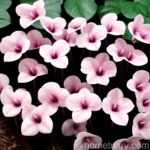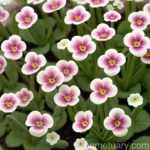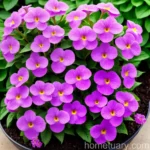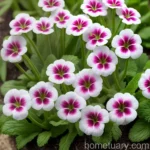The Fascinating World of Drumstick Primula (Primula denticulata ‘Cashmeriana Ruby’)
Plants are marvels of nature, offering a diverse array of species, each with its unique characteristics, requirements, and value. Among the numerous captivating plant species is the drumstick primula, scientifically known as Primula denticulata ‘Cashmeriana Ruby’. This article delves into the intriguing world of this plant, exploring its culture, uses, care needs, and much more.
What Is a Drumstick Primula (Primula denticulata ‘Cashmeriana Ruby’)?
The drumstick primula, also known as Primula denticulata ‘Cashmeriana Ruby’, is a stunning perennial plant that belongs to the Primulaceae family. It is native to the Himalayas, where its captivating blooms color the mountainous terrain. This species is renowned for its spherical clusters of delicate, tubular flowers that form atop sturdy stems, giving the impression of miniature drumsticks, hence its name.
These charming blooms come in various shades, but ‘Cashmeriana Ruby’ is particularly noted for its striking deep pink to ruby red flowers, making it a popular choice for adding vibrancy to gardens, borders, and containers.
The drumstick primula, like many other Primula species, prefers cool and moist environments with well-drained soils. Its ability to thrive in shaded areas and its low maintenance needs make it an appealing choice for both novice and experienced gardeners.
Key Takeaways – Drumstick Primula (Primula denticulata ‘Cashmeriana Ruby’)
Before delving into the specifics of cultivating and caring for the drumstick primula, let’s outline some of the key takeaways about this captivating plant.
- Scientific Name: Primula denticulata ‘Cashmeriana Ruby’
- Common Name: Drumstick primula
- Family: Primulaceae
- Native Habitat: Himalayas
- Characteristics: Spherical clusters of delicate, tubular flowers in shades of deep pink to ruby red
- Preferred Growing Conditions: Cool, moist environments with well-drained soils
Culture
Understanding the cultural requirements of the drumstick primula is essential for successfully cultivating and enjoying this captivating plant. From water needs to sunlight preferences, let’s explore the culture of Primula denticulata ‘Cashmeriana Ruby’.
Water
Proper watering is crucial for the health and vitality of the drumstick primula. Due to its preference for moist environments, regular watering is necessary to keep the soil consistently damp, but not waterlogged. During hot and dry periods, increased watering may be required to prevent the soil from drying out completely.
When watering, it’s important to ensure that the water penetrates the soil to reach the roots, as shallow watering may lead to inadequate hydration and root rot.
Sunlight
The drumstick primula thrives in partial to full shade, making it an excellent choice for areas in the garden that receive limited direct sunlight. However, it’s important to note that while the plant prefers shade, it still requires some light to bloom and maintain healthy foliage.
In regions with intense heat, providing the drumstick primula with shade from the afternoon sun is especially beneficial, as excessive heat can cause stress and negatively impact the plant’s growth and flowering.
Fertilizer
Unlike some demanding plants, the drumstick primula does not have high fertilizer requirements. However, applying a balanced, soluble fertilizer in spring can provide the plant with the nutrients it needs to support healthy growth and abundant blooms.
When applying fertilizer, it’s important to follow the manufacturer’s instructions and avoid over-fertilization, as this can lead to excessive foliage growth at the expense of blooms.
Soil
The drumstick primula thrives in well-drained, humus-rich soils that are consistently moist. It’s essential to provide the plant with soil that offers good water retention while allowing excess moisture to drain away, as waterlogged soils can lead to root rot and other issues.
If the natural soil conditions are not optimal, amending the soil with organic matter such as compost can greatly improve its structure, drainage, and nutrient content, creating a more suitable environment for the drumstick primula to flourish.
Pruning
Pruning is a valuable practice for maintaining the health and appearance of the drumstick primula. Deadheading, or removing spent blooms, not only enhances the plant’s aesthetic appeal but also promotes continuous flowering by redirecting its energy from seed production to new growth and blooms.
In addition to deadheading, removing any damaged or diseased foliage is important to prevent the spread of diseases and maintain the overall vigor of the plant.
Propagation
Propagation of the drumstick primula can be achieved through various methods, including division and seed propagation. Dividing mature plants in early spring or fall allows for the creation of new plants and promotes the rejuvenation of established ones.
Seed propagation, on the other hand, requires collecting ripe seeds and sowing them in a suitable growing medium. While seed propagation may take longer to produce mature plants, it offers a rewarding experience and allows for the creation of new varieties through cross-pollination.
Container Popularity
The drumstick primula’s adaptability to container gardening has contributed to its popularity among gardeners and plant enthusiasts. Its ability to thrive in shaded areas and its compact size make it an appealing choice for bringing color and vibrancy to outdoor and indoor spaces.
When choosing a container for the drumstick primula, it’s essential to select one with adequate drainage holes to prevent waterlogging and ensure the health of the plant. Additionally, using a well-draining potting mix specifically formulated for perennial plants can provide the ideal growing medium for container-grown drumstick primulas.
Common Diseases and Pests
While the drumstick primula is generally resilient, it is susceptible to certain diseases and pests that can affect its health and vitality. Understanding these potential issues and their management is crucial for maintaining thriving and vibrant plants.
Disease Diagnosis
Common diseases that may affect the drumstick primula include powdery mildew, leaf spot, and root rot. Powdery mildew manifests as a white, powdery growth on the plant’s foliage, while leaf spot appears as circular, discolored spots on the leaves. Root rot, caused by overly wet or waterlogged soils, can lead to yellowing and wilting of the plant’s foliage as the roots suffocate and decay.
Prompt identification and appropriate management measures, such as adjusting watering practices, improving air circulation, and using fungicidal treatments when necessary, can help prevent the spread of diseases and ensure the plant’s continued vigor.
Common Pests
Pests that may pose a threat to the drumstick primula include aphids, slugs, and snails. These pests can cause damage to the plant by feeding on its foliage, buds, and blooms, compromising its overall health and appearance.
Implementing pest control measures, such as handpicking or using eco-friendly pest deterrents, can help manage pest infestations while minimizing the use of harsh chemicals that may impact beneficial insects and the environment.
Botanist’s Tips
For those passionate about cultivating and appreciating the beauty of the drumstick primula, here are some expert tips to enhance your experience and success with this captivating plant.
-
Provide consistent moisture: Maintaining the soil moisture at an optimal level is key to the health and vigor of the drumstick primula. Regular monitoring and adjusting watering practices accordingly can help prevent issues related to under- or over-watering.
-
Choose suitable containers: When growing drumstick primulas in containers, select pots with adequate drainage and use a high-quality potting mix tailored to the needs of perennial plants. Container-grown primulas benefit from the use of mulch to retain moisture and suppress weed growth.
-
Prune and deadhead regularly: Regular deadheading and selective pruning help promote continuous blooming and maintain the plant’s tidy appearance. Removing spent blooms redirects the plant’s energy to producing new flowers and encourages a prolonged flowering period.
-
Monitor for pests and diseases: Regularly inspect the plant for signs of pests and diseases, and take proactive measures to manage and prevent issues. Creating a conducive growing environment with proper cultural practices can enhance the plant’s natural defenses against pests and diseases.
Fun Facts
Exploring the fascinating world of the drumstick primula reveals intriguing and delightful details about this remarkable plant. Here are some fun facts to enrich your appreciation for this captivating species.
-
Himalayan heritage: The drumstick primula hails from the Himalayas, where it thrives in the cool and moist mountainous regions. Its ability to endure varying climates and adapt to different conditions has made it a beloved plant worldwide.
-
Unique flower structure: The spherical clusters of tubular flowers that adorn the drumstick primula’s sturdy stems create a striking visual display, evoking the image of miniature drumsticks. These captivating blooms are a spectacle in spring and add a touch of elegance to any garden or landscape.
-
Versatile garden companion: The drumstick primula’s adaptable nature and appealing aesthetics make it an excellent companion plant for various shade-loving perennials, ferns, and woodland plants. Its vibrant blooms bring color and life to shaded areas, contributing to diverse and enchanting garden designs.
Links to External Resources
For further exploration and in-depth information about the drumstick primula, here are some valuable external resources that provide comprehensive insights into the cultivation, care, and appreciation of this enchanting plant.
- Royal Horticultural Society (RHS) – Primula denticulata
- North American Rock Garden Society (NARGS) – Primula denticulata
- Gardening Know How – Growing Drumstick Primulas
As you continue to cultivate and cherish the diverse array of plant species, may the enchanting beauty and resilience of the drumstick primula inspire your love for gardening and the natural world.
Happy gardening!















